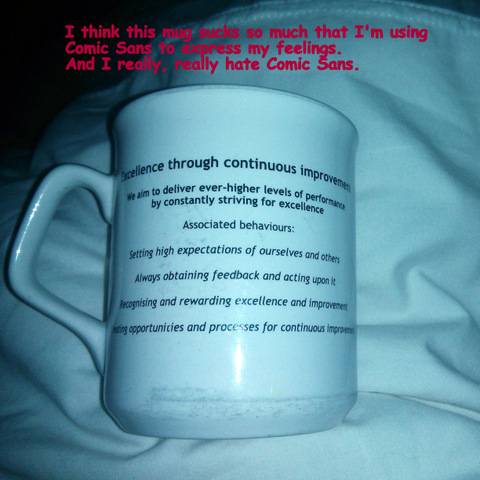Today marked a real turning point for me. I’ve been bedridden with the flu since Saturday: not a wimpy ‘mini flu’ but the real deal. The proper, old-fashioned, take to your bed for five days kinda thing. It was awful. I forgot to get my flu jab this year (sorry Mum) which was foolish.
I’ve been religiously getting a pre-winter flu jab for as long as I remember but for whatever reason, I just ‘didn’t get round to it’ this year. But I digress.
Today’s communication insights are brought to you by a corporate branded mug from a company I will not name.
A muggins moment
I realised I was on the mend earlier today when I was immensely irritated – and then hysterically amused – by a mug. A MUG. Of all the things to cheer me up and make me feel like myself again. It was a momentous occasion for three reasons: firstly I felt well enough to walk down three flights of stairs to make myself a hot drink, and then carry it all the way back up to my room without getting dizzy and needing to stop on the landing.
Secondly, I managed to find a clean mug. I live with seven other people and our crockery has a cute habit of either festering or disappearing. When you do find something, odds are, it’s going to be mismatched and nobody will claim ownership of it. Hence my discovery of this ‘motivational’ mug that looks like it wandered into the flat at some point during 2006 and hid under the sink until this morning.
Thirdly, I recognised my inner grump was returning when I looked at the mug and got ragey. The return of the inner grump means I’m pretty much healed.
Here’s the mug. I’ve expressed how I feel about this mug via font snobbery in a very mature fashion.

Why this mug sucks
I’ve mentioned before that my day job is in a corporate communications environment. I’ve also mentioned that I really like my job but some things make me cranky. ‘Message mugs’ are one of these things. If I was in a dramatic mood (let’s be real, I am) they’ve been the bane of my life since my first foray into corporate communications in 2007.
Here are my issues with this specific ‘message mug’:
- Too many catch-phrases: ‘continous improvement’, ‘exciting opportunities and processes’ – nobody talks like this!
- It uses ‘striving’, one of my most hated words in a corporate environment
- The copy is so, so patronising
- It’s unclear what they were trying to achieve by spending presumably quite a bit of cash on several of these bad boys
- There are way too many words for the format that the message is printed on. It’s a mug. It’s not a brochure or leaflet that you settle down to read at leisure, it’s a piece of crockery.
Making mugs (and other collateral) work for you
- My gut feel is that you shouldn’t do ‘message mugs’ in the first place. Chuck your logo on your mugs, for sure, but if you really care about building employee awareness of your new vision/values/behaviours, find new and engaging ways of getting face time with them. Hell, if you printed your messages on biscuit wrappers you’d probably achieve better results than stamping them on mugs (I have no hard data for this claim: I am just a sucker for biscuits). But I do promise you can afford to let your employees enjoy a cup of freakin’ tea in peace. They won’t become disengaged by not having your messaging in their face every second of every day.
- If you must do a mug, reduce the wordcount and simplify your communication objective to one thing: awareness, and awareness only. Just put one thing on there: either the company vision or the four key value words. That’s it. Plus your logo.
I assume whoever made this mug was aiming to achieve awareness of the corporate vision (the first sentence) and the corporate mission statement (the second sentence). This is already two concepts and they should’ve stopped there. But they’ve gone on to also outline some corporate behaviours to generate employee understanding of what these two concepts look like in action. Great in theory, and something that communicators need to do – just not on a mug! - Start thinking about other stuff like face-to-face conversations. Asking your people to feed into what the new behaviours should be. Engaging with senior influencers so they model the behaviours you’re trying to promote. Setting up dedicated staff awards to recognise those who do embody the changes you’re trying to promote internally. Having real conversations with real people about why this stuff matters, how it can impact the bottom line – but avoiding big pompous words.
- You can definitely achieve general low-level awareness through things like mugs, just don’t expect anything more than that from this particular format. So don’t spend lots of cash on the ‘fluffy’ stuff like posters and mugs. If you’re after greater understanding and sustained behaviour change, invest in regular, relevant communications across a variety of channels – once the mugs are out there of course 😉
If you’re not familiar with communication objective setting and the stakeholder commitment curve (Awareness, Understanding, Commitment, Action) you might find this worth a read.
Listening to: Itchin’ On A Photograph by Grouplove

